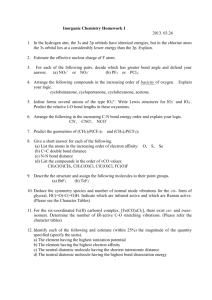
■ Lone pairs decrease the bond angle because they are more diffuse than bonding electrons. Section 1.14 ■ Molecular geometry is determined by hybridization: sp3 is tetrahedral, sp2 is trigonal planar, and sp is linear. ■ ■ ■ Section 1.15 ■ The hybridization of C, N, or O depends on the number of p bonds the atom forms: no p bonds = sp3, one p bond = sp2, and two p bonds = sp. Exceptions are carbocations and carbon radicals, which are sp2. ■ The greater the electron density in the region of orbital overlap, the shorter and stronger the bond. ■ The more s character in the orbital used to form a bond, the shorter and stronger the bond and the larger the bond angle. The shorter the bond, the stronger it is. Triple bonds are shorter and stronger than double bonds, which are shorter and stronger than single bonds. A p bond is weaker than a s bond. Section 1.16 ■ The dipole moment of a molecule depends on the magnitude and direction of all the individual bond dipoles. GLOSSARY The definitions of the key words used in each chapter can be found at the beginning of each pertinent chapter in the Study Guide/Solutions Manual. The definitions of all the key words used in this book also can be found in the Glossary on p. G-1. 76 PROBLEMS 49. Draw a Lewis structure for each of the following: a. N2H4 14 iii i. i. : b. CO32 - 2 4 Ǜ : c. N2H2 ※ X 1 iii. d. CO2 o_o CH3CH3 CH3F dipolemonenfx 原⼦ ⼤⼩ 距離 e. HOCl 2 50. a. Which of the following has a polar covalent bond? b. Which of the following has a bond closest to the ionic end of the bond spectrum? CH3NH2 . 0 CH3OH % 54 能量10 51. What is the hybridization of all the atoms (other than hydrogen) in each of the following? What are the bond angles around each atom? a. NH3 b. BH3 formdchge c. - CH3 ⾓度 差異 ) d. ·CH3 e. f. + + NH4 CH3 g. HCN h. C(CH3)4 i. j. H3O + H2C “ O 52. Draw the condensed structure of a compound that contains only carbon and hydrogen atoms and that has a. three sp3 hybridized carbons. b. one sp3 hybridized carbon and two sp2 hybridized carbons. c. two sp3 hybridized carbons and two sp hybridized carbons. 53. Predict the approximate bond angles: + a. the C ¬ N ¬ H bond angle in (CH3)2NH2 b. the C ¬ O ¬ H bond angle in CH3OH c. the C ¬ N ¬ H bond angle in (CH3)2NH d. the C ¬ N ¬ C bond angle in (CH3)2NH 54. Draw the ground-state electronic configuration for each of the following: a. Mg b. Ca2 + c. Ar d. Mg 2 + 55. Draw a Lewis structure for each of the following: a. CH3NH2 b. HNO2 c. NaNH2 d. NH2O - 56. What is the hybridization of each of the carbon and oxygen atoms in vitamin C? CH2OH HO CH O HC C C C HO O OH vitamin C 47 57. Rank the bonds from most polar to least polar. a. C ¬ O, C ¬ F, C ¬ N b. C ¬ Cl, C ¬ I, C ¬ Br c. H ¬ O, H ¬ N, H ¬ C c. CH3COOH d. C ¬ H, C ¬ C, C ¬ N 58. Draw a Lewis structure for each of the following: a. CH3CHO b. CH3OCH3 59. Draw a skeletal structure for each of the compounds in Problem 58. 60. What is the hybridization of the indicated atom in each of the following? O b. c. CH3CH2OH CH3CCH3 61. Predict the approximate bond angles for the following: a. CH3CH CH2 a. the C ¬ N ¬ H bond angle in CH3CH2NH2 b. the F ¬ B ¬ F bond angle in - BF4 d. CH3C e. N CH3CH NCH3 f. CH3OCH2CH3 f. (CH3)2 N ¬ H c. the C ¬ C ¬ N bond angle in CH3C ‚ N d. the C ¬ C ¬ N bond angle in CH3CH2NH2 62. Show the direction of the dipole moment in each of the following bonds (use the electronegativities given in Table 1.3): a. H3C ¬ Br b. H3C ¬ Li c. HO ¬ NH2 d. I ¬ Br e. H3C ¬ OH 63. Draw the missing lone-pair electrons and assign the missing formal charges for the following: H a. H C H O b. H H H H C O H H H c. H C H d. H O H C N H H H 64. a. Which of the indicated bonds in each molecule is shorter? b. Indicate the hybridization of the C, O, and N atoms in each of the molecules. CH3 H 1. CH3CH CHC 3. CH O 2. CH3CCH2 CH2CH2N CH3NH 5. CHCH3 C CHC C C H H CH3 Br CH2CH2CH2 Cl H 4. OH CHC C C 6. H H 65. For each of the following molecules, indicate the hybridization of each carbon and give the approximate values of all the bond angles: a. CH3C ‚ CH b. CH3CH “ CH2 c. CH3CH2CH3 d. c. (CH3)2CHCH(CH3)CH2C(CH3)3 CH2 CH CH CH2 66. Draw a Lewis structure for each of the following: a. (CH3)3COH b. CH3CH(OH)CH2CN 67. Draw a skeletal structure for each of the compounds in Problem 66. 68. Rank the following compounds from highest dipole moment to lowest dipole moment: Cl Cl Cl Cl 69. In which orbitals are the lone pairs in nicotine? N N CH3 nicotine nicotine increases the concentration of dopamine in the brain; the release of dopamine makes a person feel good—the reason nicotine is addictive 48 Cl Br Cl o fe e te oert -5 PH-pkatgilo.510h-o.zt.no -0,5



